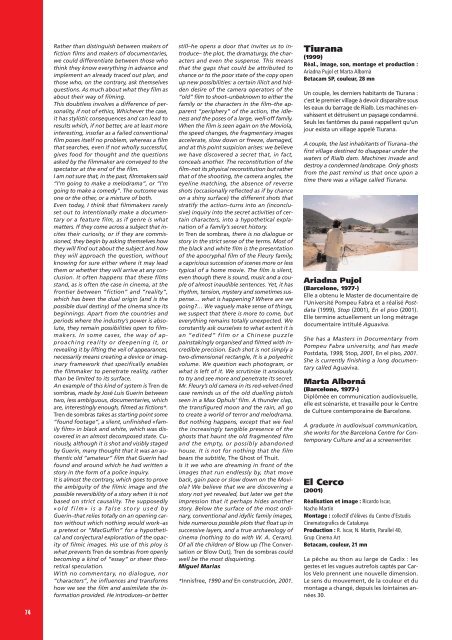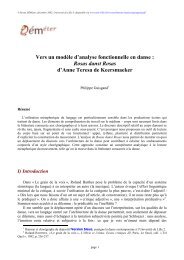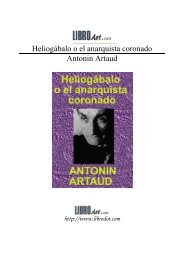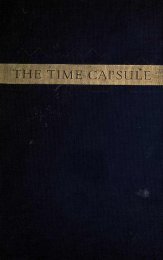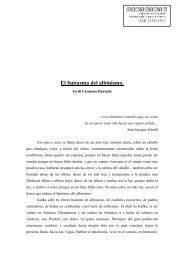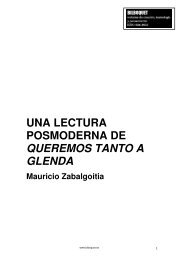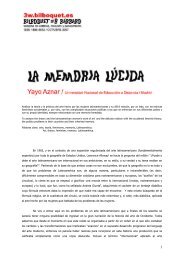07 cata 05 corr-v5 - bilboquet
07 cata 05 corr-v5 - bilboquet
07 cata 05 corr-v5 - bilboquet
- No tags were found...
Create successful ePaper yourself
Turn your PDF publications into a flip-book with our unique Google optimized e-Paper software.
Rather than distinguish between makers offiction films and makers of documentaries,we could differentiate between those whothink they know everything in advance andimplement an already traced out plan, andthose who, on the contrary, ask themselvesquestions. As much about what they film asabout their way of filming.This doubtless involves a difference of personality,if not of ethics, Whichever the case,it has stylistic consequences and can lead toresults which, if not better, are at least moreinteresting, insofar as a failed conventionalfilm poses itself no problem, whereas a filmthat searches, even if not wholly successful,gives food for thought and the questionsasked by the filmmaker are conveyed to thespectator at the end of the film.I am not sure that, in the past, filmmakers said“I’m going to make a melodrama”, or “I’mgoing to make a comedy”. The outcome wasone or the other, or a mixture of both.Even today, I think that filmmakers rarelyset out to intentionally make a documentaryor a feature film, as if genre is whatmatters. If they come across a subject that incitestheir curiosity, or if they are commissioned,they begin by asking themselves howthey will find out about the subject and howthey will approach the question, withoutknowing for sure either where it may leadthem or whether they will arrive at any conclusion.It often happens that these filmsstand, as is often the case in cinema, at thefrontier between “fiction” and “reality”,which has been the dual origin (and is thepossible dual destiny) of the cinema since itsbeginnings. Apart from the countries andperiods where the industry’s power is absolute,they remain possibilities open to filmmakers.In some cases, the way of approachingreality or deepening it, orrevealing it by lifting the veil of appearances,necessarily means creating a device or imaginaryframework that specifically enablesthe filmmaker to penetrate reality, ratherthan be limited to its surface.An example of this kind of system is Tren desombras, made by José Luis Guerín betweentwo, less ambiguous, documentaries, whichare, interestingly enough, filmed as fictions*.Tren de sombras takes as starting point some“found footage”, a silent, unfinished «familyfilm» in black and white, which was discoveredin an almost decomposed state. Curiously,although it is shot and visibly stagedby Guerín, many thought that it was an authenticold “amateur” film that Guerín hadfound and around which he had written astory in the form of a police inquiry.It is almost the contrary, which goes to provethe ambiguity of the filmic image and thepossible reversibility of a story when it is notbased on strict causality. The supposedly«old film» is a false story used byGuerin–that relies totally on an opening cartonwithout which nothing would work–asa pretext or “MacGuffin” for a hypotheticaland conjectural exploration of the opacityof filmic images. His use of this ploy iswhat prevents Tren de sombras from openlybecoming a kind of “essay” or sheer theoreticalspeculation.With no commentary, no dialogue, nor“characters”, he influences and transformshow we see the film and assimilate the informationprovided. He introduces–or betterstill–he opens a door that invites us to introduce–the plot, the dramaturgy, the charactersand even the suspense. This meansthat the gaps that could be attributed tochance or to the poor state of the copy openup new possibilities: a certain illicit and hiddendesire of the camera operators of the“old” film to shoot–unbeknown to either thefamily or the characters in the film–the apparent“periphery” of the action, the idlenessand the poses of a large, well-off family.When the film is seen again on the Moviola,the speed changes, the fragmentary imagesaccelerate, slow down or freeze, damaged,and at this point suspicion arises: we believewe have discovered a secret that, in fact,conceals another. The reconstitution of thefilm–not its physical reconstitution but ratherthat of the shooting, the camera angles, theeyeline matching, the absence of reverseshots (occasionally reflected as if by chanceon a shiny surface) the different shots thatstratify the action–turns into an (inconclusive)inquiry into the secret activities of certaincharacters, into a hypothetical explanationof a family’s secret history.In Tren de sombras, there is no dialogue orstory in the strict sense of the terms. Most ofthe black and white film is the presentationof the apocryphal film of the Fleury family,a capricious succession of scenes more or lesstypical of a home movie. The film is silent,even though there is sound, music and a coupleof almost inaudible sentences. Yet, it hasrhythm, tension, mystery and sometimes suspense…what is happening? Where are wegoing?… We vaguely make sense of things,we suspect that there is more to come, buteverything remains totally unexpected. Weconstantly ask ourselves to what extent it isan “edited” film or a Chinese puzzlepainstakingly organised and filmed with incredibleprecision. Each shot is not simply atwo-dimensional rectangle, It is a polyedricvolume. We question each photogram, orwhat is left of it. We scrutinise it anxiouslyto try and see more and penetrate its secret.Mr. Fleury’s old camera in its red-velvet-linedcase reminds us of the old duelling pistolsseen in a Max Ophuls’ film. A thunder clap,the transfigured moon and the rain, all goto create a world of terror and melodrama.But nothing happens, except that we feelthe increasingly tangible presence of theghosts that haunt the old fragmented filmand the empty, or possibly abandonedhouse. It is not for nothing that the filmbears the subtitle, The Ghost of Thuit.Is it we who are dreaming in front of theimages that run endlessly by, that moveback, gain pace or slow down on the Moviola?We believe that we are discovering astory not yet revealed, but later we get theimpression that it perhaps hides anotherstory. Below the surface of the most ordinary,conventional and idyllic family images,hide numerous possible plots that float up insuccessive layers, and a true archaeology ofcinema (nothing to do with W. A. Ceram).Of all the children of Blow up (The Conversationor Blow Out), Tren de sombras couldwell be the most disquieting.Miguel Marias*Innisfree, 1990 and En construcción, 2001.Tiurana(1999)Réal., image, son, montage et production :Ariadna Pujol et Marta AlbornàBetacam SP, couleur, 28 mnUn couple, les derniers habitants de Tiurana :c’est le premier village à devoir disparaître sousles eaux du barrage de Rialb. Les machines envahissentet détruisent un paysage condamné.Seuls les fantômes du passé rappellent qu’unjour exista un village appelé Tiurana.A couple, the last inhabitants of Tiurana–thefirst village destined to disappear under thewaters of Rialb dam. Machines invade anddestroy a condemned landscape. Only ghostsfrom the past remind us that once upon atime there was a village called Tiurana.Ariadna Pujol(Barcelone, 1977-)Elle a obtenu le Master de documentaire del’Université Pompeu Fabra et a réalisé Postdata(1999), Stop (2001), En el piso (2001).Elle termine actuellement un long métragedocumentaire intitulé Aguaviva.She has a Masters in Documentary fromPompeu Fabra university, and has madePostdata, 1999, Stop, 2001, En el piso, 2001.She is currently finishing a long documentarycalled Aguaviva.Marta Alborná(Barcelone, 1977-)Diplômée en communication audiovisuelle,elle est scénariste, et travaille pour le Centrede Culture contemporaine de Barcelone.A graduate in audiovisual communication,she works for the Barcelona Centre for ContemporaryCulture and as a screenwriter.El Cerco(2001)Réalisation et image : Ricardo Iscar,Nacho MartínMontage : collectif d’élèves du Centre d’EstudisCinematografics de CatalunyaProduction : R. Iscar, N. Martín, Parallel 40,Grup Cinema ArtBetacam, couleur, 21 mnLa pêche au thon au large de Cadix : lesgestes et les vagues autrefois captés par CarlosVelo prennent une nouvelle dimension.Le sens du mouvement, de la couleur et dumontage a changé, depuis les lointaines années30.74


